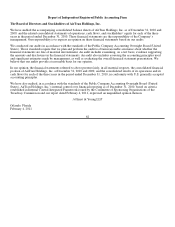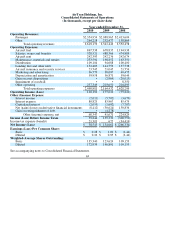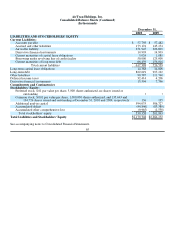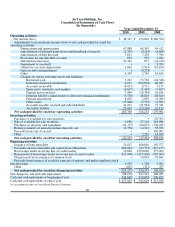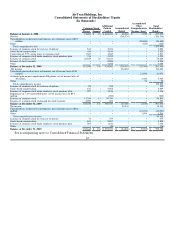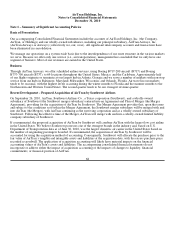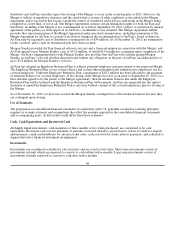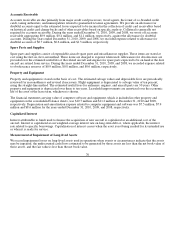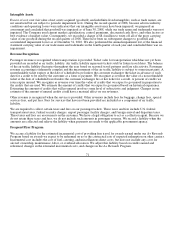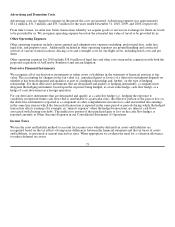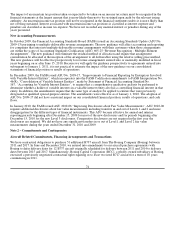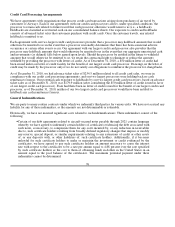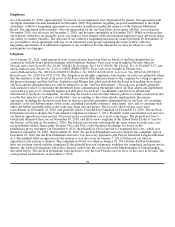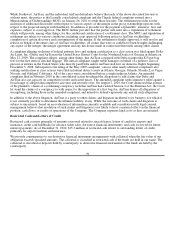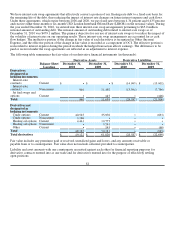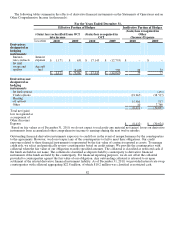Airtran 2010 Annual Report Download - page 80
Download and view the complete annual report
Please find page 80 of the 2010 Airtran annual report below. You can navigate through the pages in the report by either clicking on the pages listed below, or by using the keyword search tool below to find specific information within the annual report.
We also sell credits in our A+ Rewards Program to third parties, such as credit card companies, internet service providers,
and car rental agencies. Revenue from the sale of credits is deferred and recognized as passenger revenue when
transportation is expected to be provided, based on estimates of fair value of travel with similar restrictions. The
remaining portion, which is the excess of the total sales proceeds over the estimated fair value of the transportation to be
provided, is recognized in other revenue at the time of sale. A change to the time period over which the credits are used
(currently one to two years), the actual redemption activity, or our estimate of the amount of, or fair value of expected
transportation could have a significant impact on our revenue in the year of change as well as future years.
Stock Based Employee Compensation
We recognize the financial accounting cost of employee services received in exchange for awards of equity instruments
based on the fair value of each instrument at the date of grant. Compensation expense is recognized ratably over the
period during which an employee is required to provide service in exchange for an award. The fair value of a stock option
grant is estimated using an option pricing model. The fair value of a restricted stock award is based on the trading price of
our common stock on the date of grant. The fair value of performance shares is based on simulated stock prices generated
by a multi-factor Montecarlo simulation model covering the period from the grant date through the end of the
performance period.
Lump-sum Payments Made Pursuant to a Collective Bargaining Agreement
In November 2010, a collective bargaining agreement with the Air Line Pilots Association (ALPA) was ratified by the
AirTran pilots. The new agreement took effect as of December 1, 2010 and becomes amendable in December 2015. The
agreement provides for lump-sum payments aggregating $17 million to be made to the pilots. Commencing December 1,
2010, the lump sum payments are being amortized over five years for financial accounting purposes to salaries, wages and
benefits expense because such payments reduced rate increases during the contract period that would otherwise have
existed.
Fuel Tax Expense
Our fuel tax expense for the year ended December 31, 2010 was reduced by $7.5 million due to a refund of fuel taxes paid
between April 2007 and February 2009. Fuel tax expense is a component of aircraft fuel expense.
Aircraft Maintenance
Aircraft maintenance costs are expensed as incurred. Maintenance reserves paid to aircraft lessors in advance of the
performance of major maintenance activities are recorded as deposits and then recognized as maintenance expense when
the maintenance is performed. The personnel costs of our employees performing aircraft maintenance activities are
classified as salaries, wages, and benefits expense. The costs of replacement parts and services performed by third parties
are classified as maintenance, materials, and repairs expense. Maintenance expense is recognized when the work is
performed if the work is performed by our employees or by third party FAA approved contractors pursuant to
arrangements whereby our contractual liability to a contractor is incurred at the time the work is performed. The costs of
line maintenance activities, overhauls of airframes, overhauls of engines for B737 aircraft, and repairs of certain
component parts are recognized as expense when the repair is performed.
Maintenance expense is recognized based on flight hours or landings if we incur a contractual liability to a third party
FAA-approved contractor to repair or overhaul major component parts based on a contractually specified rate per flight
hour or landing, as applicable. Accordingly, maintenance repair costs for certain major components, including engines for
B717 aircraft, are expensed monthly based on flight hours flown or landings, as applicable.
72


